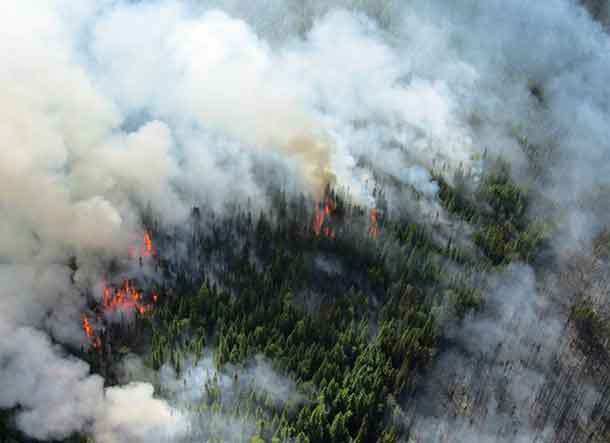
lightning and human-caused fires daily. Fire management personnel are working to assess each fire, take action
with ground and air attack as needed and if in a remote location and beneficial to the forest the fire will be monitored.
13 New Fires in Northwest
by Deb MacLean
THUNDER BAY – WILDFIRE UPDATE – There were 13 new fires confirmed by early evening on August 09 in the Northwest Region and there were 23 confirmed fires by day’s end on August 08. The bulk of the fires continue to be located in the northern districts of Nipigon, Sioux Lookout and Red Lake although southern districts are picking up new fires including Kenora, Dryden and Thunder Bay.
The Aviation, Forest Fire and Emergency Services program in the Northwest Region is dealing with multiple lightning and human-caused fires daily. Fire management personnel are working to assess each fire, take action
with ground and air attack as needed and if in a remote location and beneficial to the forest the fire will be monitored.
Although a number of fires are also declared out daily, there are over 90 active fires burning in the region at this time.
The fire hazard ranges from low in the southern sectors which have received rain to moderate and high in the central and northern sectors.
To track the fire hazards and to see a complete list of fires across the province click on our interactive map. You can also get the latest update on the condition of any fire by clicking the fire icons.
The majority of the new fires are caused by lightning.
Out of Province Deployment
Currently there are approximately 150 staff supporting the province of British Columbia in their fire management efforts.
Ontario, as part of the Great Lakes Forest Fire Compact (GLFFC) including Michigan, Minnesota and Wisconsin has formed international crews of firefighters currently deployed to British Columbia.
Ontario continues to have firefighting staff on the ground in British Columbia to help support ongoing firefighting efforts. This is being done while also ensuring we have the necessary firefighting personnel here at home. So far since mid-July, four large contingents of FireRangers that had been deployed out of province have now returned to Ontario from BC.
The public is urged to take an active role in preventing more fires. This can be done by not burning when it is windy, monitoring your fire and ensuring that you have water nearby to extinguish your fire. As a reminder, there is no day burning of brush and grass.
Planning to have a campfire?
Here are some tips on how to safely enjoy your campfire and avoid the costs and dangers that can arise from an unextinguished or unattended campfire:
- Choose your site carefully. Select a site with easy access to water that is sheltered from high winds. The fire must be built on bare rock or non-combustible material.
- Prepare the site. Clear a one metre space around your campfire site and remove all pine needles, grasses, leaves and twigs.
- Keep your fire small. By law, your campfire cannot exceed one metre in height and one metre in diameter.
- Stay nearby. Never leave your campfire unattended.
- Put your fire out. Soak your fire with water.
- Be sure the fire is extinguished. Stir the ashes with a stick to uncover hot coals and then soak it again!
Ontario has increased the maximum fines for individuals and corporations for starting forest fires.
Increased Fines for Starting a Forest Fire
Fire numbers and online information:
- Forest Fire Reporting Number – 310-FIRE (3473)
- Follow us on Twitter: in English @ONForestFires or in French @ONFeuDeForêt
- For guidelines on safe outdoor fire management ontario.ca/fireprevention
